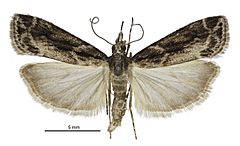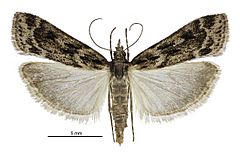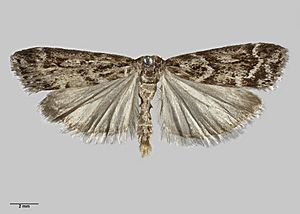Scoparia illota facts for kids
Quick facts for kids Scoparia illota |
|
|---|---|
 |
|
| Male | |
 |
|
| Female | |
| Scientific classification | |
| Kingdom: | |
| Phylum: | |
| Class: | |
| Order: | |
| Family: | |
| Genus: |
Scoparia
|
| Species: |
S. illota
|
| Binomial name | |
| Scoparia illota Philpott, 1919
|
|
Scoparia illota is a species of moth in the family Crambidae. It is endemic to New Zealand. The larvae of this species are leaf miners.
Taxonomy
It was described by Alfred Philpott in 1919 using specimens collected at Cromarty in Preservation Inlet as well as specimen collected between Blue Cliffs Beach and the Knife and Steel harbour in Southland. The species was discussed and illustrated by George Hudson in his 1928 book The butterflies and moths of New Zealand.' However the placement of this species within the genus Scoparia is in doubt. As a result, this species has also been referred to as Scoparia (s.l.) illota. The holotype specimen is held at the Auckland War Memorial Museum.
Description
The wingspan is 18–20 mm. The forewings are blackish-fuscous, irrorated with white. Both the first and second line are white. The hindwings are grey. Adults have been recorded on wing in December.
Distribution
This species is endemic to New Zealand. It is found in the forests of southern New Zealand. It is locally common in Thomsons Bush in Invercargill as well on the Cascade Road in South Westland.
Life stages
This species' larvae are leaf miners. They form silk tunnels amongst the leaves of their host plants.
Host species
Pyrrosia eleagnifolia is a host species for the larvae of this moth.


